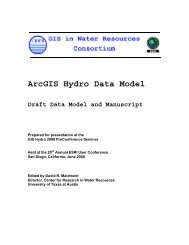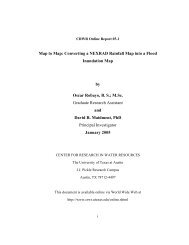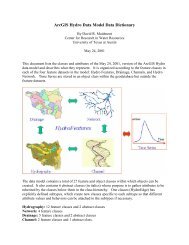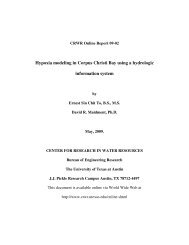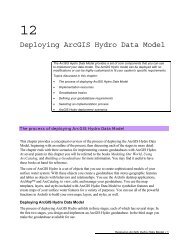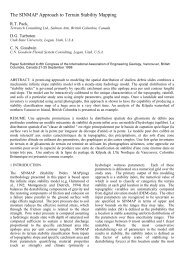View the Whole Report - Center for Research in Water Resources ...
View the Whole Report - Center for Research in Water Resources ...
View the Whole Report - Center for Research in Water Resources ...
Create successful ePaper yourself
Turn your PDF publications into a flip-book with our unique Google optimized e-Paper software.
Samples T49-T108<br />
Samples T49-T108 were secured as multiple <strong>in</strong>dividual samples per stage per site.<br />
(Stage <strong>in</strong> this context refers to <strong>the</strong> category of sampl<strong>in</strong>g location.) In addition to <strong>the</strong><br />
upstream pond stage, samples were collected <strong>in</strong> contributary flow concentrations adjacent<br />
to <strong>the</strong> upstream retention area to fur<strong>the</strong>r explore overall efficiencies associated with <strong>the</strong><br />
study <strong>in</strong>stallations. In order to differentiate samples collected <strong>in</strong> this manner, upstream<br />
contributary samples are designated with an upstream c descriptor, and samples collected<br />
from upstream ponds are designated with an upstream p descriptor <strong>in</strong> data and results<br />
tables.<br />
Samples T49-T72 were collected similarly at Site 6. Multiple, <strong>in</strong>dividual samples<br />
were collected <strong>for</strong> each stage: upstream flow concentrations, upstream pond locations,<br />
and downstream locations. S<strong>in</strong>ce <strong>the</strong>re were m<strong>in</strong>or unfiltered flows from sources exterior<br />
to <strong>the</strong> system, downstream samples were ga<strong>the</strong>red at <strong>the</strong> filter face. Sample groups T49-<br />
T60 (see Figure A10 <strong>in</strong> Appendix A) and T60-T72 (see Figure A11 <strong>in</strong> Appendix A) were<br />
collected from <strong>the</strong> same event at a time differential of approximately 1.5 hours so that<br />
changes result<strong>in</strong>g over time could be identified.<br />
Samples T72-T84 (see Figure A12 <strong>in</strong> Appendix A) were collected at Site 3<br />
accord<strong>in</strong>g to <strong>the</strong> methodology described <strong>for</strong> <strong>the</strong> group. The majority of downstream<br />
samples were collected along <strong>the</strong> face of <strong>the</strong> fence, although a s<strong>in</strong>gle sample was<br />
collected <strong>in</strong> a small flow concentration.<br />
Samples T85-T96 (see Figure A13 <strong>in</strong> Appendix A) were collected <strong>in</strong> a similar<br />
fashion at Site 6. Unfiltered flows from external sources at <strong>the</strong> downstream stage were<br />
observed, and attempts to select and sample isolated <strong>in</strong>-stream locations were per<strong>for</strong>med.<br />
Additional downstream samples were collected at <strong>the</strong> face of <strong>the</strong> fence. Over-topp<strong>in</strong>g<br />
result<strong>in</strong>g from large retention volumes precluded ord<strong>in</strong>ary downstream sampl<strong>in</strong>g <strong>for</strong> set<br />
T97-T108 (see Figure A14 <strong>in</strong> Appendix A). In this case, samples were ga<strong>the</strong>red from<br />
flows downstream <strong>in</strong> relation to a recently <strong>in</strong>stalled rock berm. Any samples attributed<br />
strictly to <strong>the</strong> operation of a rock berm are differentiated by <strong>the</strong> bold<strong>in</strong>g of <strong>the</strong> sample<br />
descriptor <strong>in</strong> <strong>the</strong> data and results tables.<br />
64




